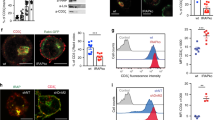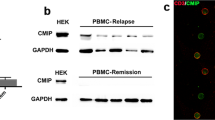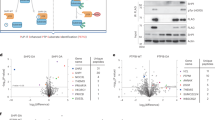Abstract
Signals that emanate from the pre-T cell receptor (pre-TCR) regulate multiple processes required for the development of the αβ T cell lineage. In contrast to the γδ TCR, the pre-TCR localizes cell-autonomously to membrane rafts, where it appears to signal in a constitutive and ligand-independent manner. We addressed here the role played by structural features specific to the cytoplasmic domain of the pre-TCRα chain (pTα). More specifically, we examined a COOH-terminal proline-rich sequence that might play a role in signal transduction and a juxtamembrane cysteine residue that could be a target for palmitoylation, thus allowing spontaneous raft localization. Expression of pTα mutants in transgenic mice, retrovirally transduced T cell precursors and cell lines showed that the pTα cytoplasmic tail, in particular the proline-rich domain, plays a crucial role in pre-TCR signaling and T cell development. In contrast, the pTα juxtamembrane cysteine appeared to be dispensable for pre-TCR function.
This is a preview of subscription content, access via your institution
Access options
Subscribe to this journal
Receive 12 print issues and online access
$209.00 per year
only $17.42 per issue
Buy this article
- Purchase on Springer Link
- Instant access to full article PDF
Prices may be subject to local taxes which are calculated during checkout






Similar content being viewed by others
References
Shortman, K. & Wu, L. Early T lymphocyte progenitors. Annu. Rev. Immunol. 14, 29–47 (1996).
Aifantis, I., Feinberg, J., Fehling, H. J., Di Santo, J. P. & von Boehmer, H. Early T cell receptor β gene expression is regulated by the pre-T cell receptor-CD3 complex. J. Exp. Med. 190, 141–144 (1999).
von Boehmer, H. et al. Pleiotropic changes controlled by the pre-T cell receptor. Curr. Opin. Immunol. 11, 135–142 (1999).
Aifantis, I. et al. On the role of the pre-T cell receptor in αβ versus γδ T lineage commitment. Immunity 9, 649–655 (1998).
Saint-Ruf, C. et al. Analysis and expression of a cloned pre-T cell receptor gene. Science 266, 1208–1212 (1994).
Bruno, L., Rocha, B., Rolink, A., von Boehmer, H. & Rodewald, H. R. Intra- and extra-thymic expression of the pre-T cell receptor alpha gene. Eur. J. Immunol. 25, 1877–1882 (1995).
Barber, D. F., Passoni, L., Wen, L., Geng, L. & Hayday, A. C. The expression in vivo of a second isoform of pTα: implications for the mechanism of pTα action. J. Immunol. 161, 11–16 (1998).
Saint-Ruf, C., Lechner, O., Feinberg, J. & von Boehmer, H. Genomic structure of the human pre-T cell receptor α chain and expression of two mRNA isoforms. Eur. J. Immunol. 28, 3824–3831 (1998).
Ramiro, A. R., Trigueros, C., Marquez, C., San Millan, J. L. & Toribio, M. L. Regulation of pre-T cell receptor (pTα-TCRβ) gene expression during human thymic development. J. Exp. Med. 184, 519–530 (1996).
Viola, A., Schroeder, S., Sakakibara, Y. & Lanzavecchia, A. T lymphocyte costimulation mediated by reorganization of membrane microdomains. Science 283, 680–682 (1999).
Saint-Ruf, C. et al. Different initiation of pre-TCR and γδTCR signalling. Nature 406, 524–527 (2000).
Gibbons, D. et al. The biological activity of natural and mutant pTα alleles. J. Exp. Med. 194, 695–703 (2001).
Irving, B. A., Alt, F. W. & Killeen, N. Thymocyte development in the absence of pre-T cell receptor extracellular immunoglobulin domains. Science 280, 905–908 (1998).
Resh, M. D. Myristylation and palmitylation of Src family members: the fats of the matter. Cell 76, 411–413 (1994).
Zhang, W., Trible, R. P. & Samelson, L. E. LAT palmitoylation: its essential role in membrane microdomain targeting and tyrosine phosphorylation during T cell activation. Immunity 9, 239–246 (1998).
Nishizawa, K., Freund, C., Li, J., Wagner, G. & Reinherz, E. L. Identification of a proline-binding motif regulating CD2-triggered T lymphocyte activation. Proc. Natl Acad. Sci. USA 95, 14897–14902 (1998).
Hahn, W. C. & Bierer, B. E. Separable portions of the CD2 cytoplasmic domain involved in signaling and ligand avidity regulation. J. Exp. Med. 178, 1831–1836 (1993).
Bell, G. M., Fargnoli, J., Bolen, J. B., Kish, L. & Imboden, J. B. The SH3 domain of p56lck binds to proline-rich sequences in the cytoplasmic domain of CD2. J. Exp. Med. 183, 169–178 (1996).
Holdorf, A. D. et al. Proline residues in CD28 and the Src homology (SH)3 domain of Lck are required for T cell costimulation. J. Exp. Med. 190, 375–384 (1999).
Fehling, H. J. et al. Restoration of thymopoiesis in pTα−/− mice by anti-CD3ɛ antibody treatment or with transgenes encoding activated Lck or tailless pTα. Immunity 6, 703–714 (1997).
Lacorazza, H. D., Porritt, H. E. & Nikolich-Zugich, J. Dysregulated Expression of ore-Tα reveals the opposite effects of Pre-TCR at successive stages of T cell development. J. Immunol. 167, 5689–5696 (2001).
Ory, D. S., Neugeboren, B. A. & Mulligan, R. C. A stable human-derived packaging cell line for production of high titer retrovirus/vesicular stomatitis virus G pseudotypes. Proc. Natl. Acad. Sci. USA 93, 11400–11406 (1996).
Aifantis, I., Gounari, F., Scorrano, L., Borowski, C. & von Boehmer, H. Constitutive pre-TCR signaling promotes differentiation through Ca2+ mobilization and activation of NF-κB and NFAT. Nature Immunol. 2, 403–409 (2001).
Pogue, S. L. & Goodnow, C. C. Gene dose-dependent maturation and receptor editing of B cells expressing immunoglobulin (Ig)G1 or IgM/IgG1 tail antigen receptors. J. Exp. Med. 191, 1031–1044 (2000).
Fehling, H. J., Krotkova, A., Saint-Ruf, C. & von Boehmer, H. Crucial role of the pre-T-cell receptor α gene in development of αβ but not γδ T cells. Nature 375, 795–798 (1995).
Reizis, B. & Leder, P. Expression of the mouse pre-T cell receptor α gene is controlled by an upstream region containing a transcriptional enhancer. J. Exp. Med. 189, 1669–1678 (1999).
Buer, J., Aifantis, I., DiSanto, J. P., Fehling, H. J. & von Boehmer, H. Role of different T cell receptors in the development of pre-T cells. J. Exp. Med. 185, 1541–1547 (1997).
Acknowledgements
Supported by the NIH (grants A147281 and A145846 to H. v. B.), a “Eugenia Spanopoulou” – Irvington Institute grant (to I. A.) and a National Science Foundation grant (to C. B.). We thank B. Reizis for LR2 cell line and R. Mulligan for the MMLV-based retroviral vector; M. Prakriya and L. Scorrano for their advice and help with the Ca2+ measurements; S. Hoeflinger for technical assistance; H. Levine and M. Cantley for cell sorting; and E. Smith for help with preparation of the manuscript.
Author information
Authors and Affiliations
Corresponding author
Ethics declarations
Competing interests
The authors declare no competing financial interests.
Rights and permissions
About this article
Cite this article
Aifantis, I., Borowski, C., Gounari, F. et al. A critical role for the cytoplasmic tail of pTα in T lymphocyte development. Nat Immunol 3, 483–488 (2002). https://doi.org/10.1038/ni779
Received:
Accepted:
Published:
Issue Date:
DOI: https://doi.org/10.1038/ni779
This article is cited by
-
Transcription factors and target genes of pre-TCR signaling
Cellular and Molecular Life Sciences (2015)
-
How the TCR balances sensitivity and specificity for the recognition of self and pathogens
Nature Immunology (2012)
-
Checkpoints in lymphocyte development and autoimmune disease
Nature Immunology (2010)
-
Molecular mechanisms that control mouse and human TCR-αβ and TCR-γδ T cell development
Seminars in Immunopathology (2008)
-
Key factors in the organized chaos of early T cell development
Nature Immunology (2007)



